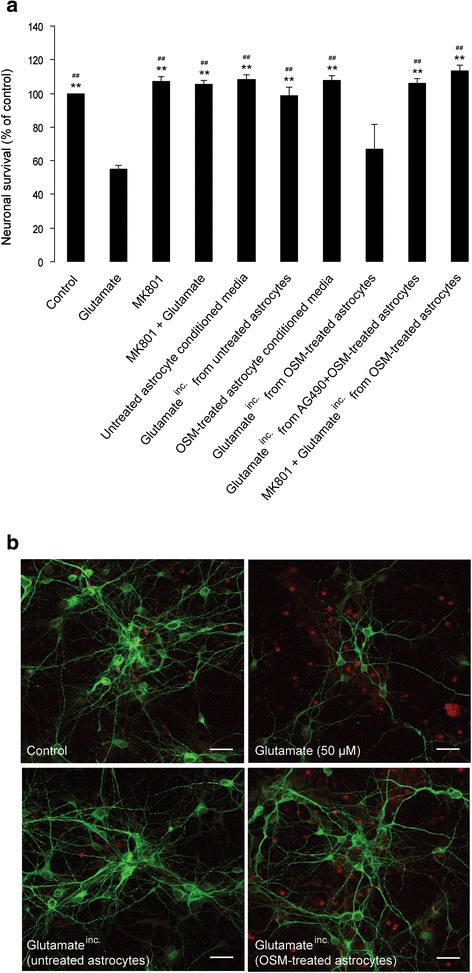Fig. 4.

OSM-induced inhibition of astrocytic glutamate uptake promotes NMDA-mediated excitotoxicity in cortical neurons in vitro. Primary cortical astrocyte cultures from wild-type (C57BL/6J) mouse neonates (P2) were treated with OSM (10 ng/mL, for 24 h) in the absence or presence of a JAK/STAT3 inhibitor (AG490, 25 μM; added 2 h prior to OSM). Following OSM treatment, the cultures were washed once using warm HBSS and incubated with glutamate (100 μM, diluted in Neurobasal media) for 30 min. The resulting astrocyte supernatant, designated as glutamateinc. (see the “Methods” section), was applied (diluted 1:1 ratio in neuronal culture media) to 6-day-old neuronal cultures obtained from embryonic (~E15) mouse cortex. As a positive control, neuronal cultures were treated with 50 μM glutamate, in the absence or presence of the NMDA receptor antagonist MK-801 (30 μM, added 30 min prior to glutamate treatment). Following glutamate treatment (for 1 h), new medium was added to the neuronal cultures and they were incubated at 37 °C in a CO2 incubator. a 24 h after glutamate treatment, cell viability was measured using a colorimetric MTT assay. OD measurements were made at 570 nm, with a blank correction made at 630 nm. Data are presented as percentage of untreated (control) neurons; each bar represents the average of four independent experiments done in quadruplicates. **p < 0.001 (compared to glutamate); ## p < 0.001 (compared to glutamateinc. from OSM-treated astrocytes); one-way ANOVA using Bonferroni correction. b 4 h after glutamate treatment, cells were fixed in 4 % paraformaldehyde, washed, and co-stained anti-MAP2 antibody (in green, neuronal marker) and propidium iodide (in red, showing cell death); scale bar corresponds to 25 μm
